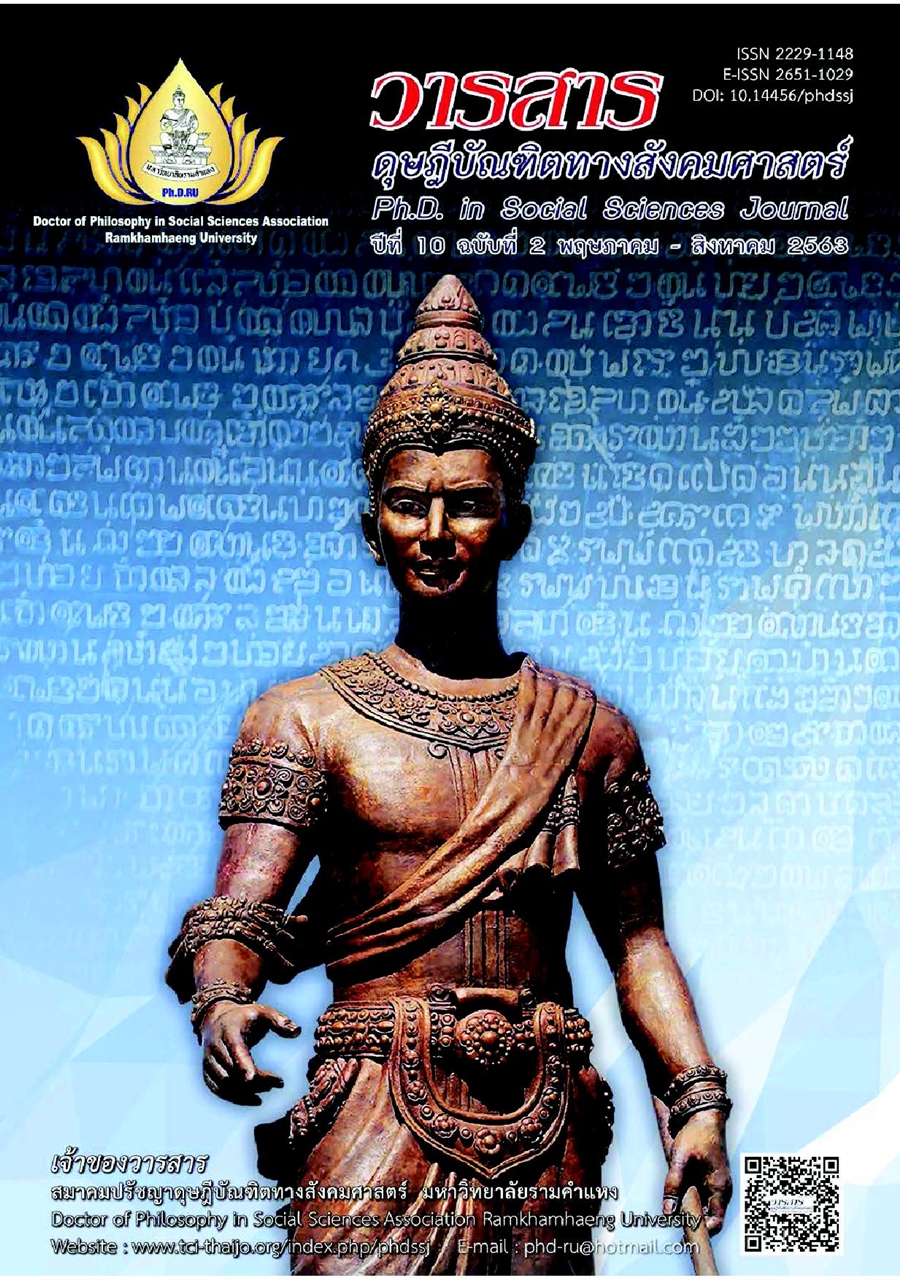A Causal Model of Factors Influencing Business Success of Electrical and Electronic Part Industries in Thailand
Main Article Content
Abstract
This research aimed on analyzing the business success model of the electrical and electronic part industries in Thailand. Data were collected from 385 electrical and electronic part industry entrepreneurs. The statistics used to analyze the data was Structural Equation Model (SEM).
Research results were as follows: the analysis received was consistent with the empirical data, with the accepted homogeneity index. Therefore, it can be concluded that the results of this analysis are consistent with the empirical data. Therefore, the business can follow the model used as a tool to enhance the business performance in order for the business to have good performance which is the basis of sustainability in creating a competitive advantage leading to business success. Also found that the results of path analysis found that the factors of marketing strategy, dynamic competencies, technological innovation management and competitive advantage perform as the direct influential factors to the business success for electrical and electronic part industries in Thailand at statistical significantly.
Article Details
Academic articles, research articles, and book reviews in the Ph.D. in Social Sciences Journal are author’s opinions, and not the publisher’s, and is not the responsibility of the Ph.D. in Social Sciences Journal Philosophy Association, Ramkhamhaeng University. (In the case that research is done on human, the researcher has to be trained in Ethics for Doing Research on Human Training and has to produce the evidence of the training).
References
Bamossy, G. J., & Solomon, M. R. (2016). Consumer behaviour: A European perspective. Pearson Education.
Bogoslaw, D. (2010). Tough Times Spur Shifts in Corporate R & D Spending. Bloomberg Business Week.
Chairat S., Sewetomboon K., & Songsiroj, N. (2012). Relationship between systems Strategic Information and the Competitive Advantage of the Telecommunications Business in Thailand. Journal of Accounting and Management, 4(1), 69-78. [In Thai]
Chanchai, A. (2003). Towards business excellence. Strategic Planning and Preparation of BSC = Balanced Scorecard (6th edition) (revised version). Chulalongkorn University Printing House. [In Thai]
Chien, S. Y., & Tsai, C. H. (2012). Dynamic capability, knowledge, learning and firm performance. Journal of Organizational Change Management, 25(3), 434-444.
Cui, A. S., Griffith, D. A., & Cavusgil, S. T. (2005). The Influence of Competitive Intensive and Market Dynamism on Knowledge Management Capabilities of MNC Subsidiaries. Journal of International Marketing, 13(3), 32-53.
Damanpour, F. (1987). The adoption of technological, administrative, and ancillary innovations: Impact of organizational factors. Journal of Management, 13(4), 675-688.
Department of Industrial Promotion. (2017). Electrical and Electronics Industry, Retrieved from http://strategy.dip.go.th
Dholakia, U. M. (1997). An investigation of some determinants of brand commitment: ACR North American Advances. Association for Consumer Research.
Diamantopoulos, A., Siguaw, J. A., & Siguaw, J. A. (2000). Introducing LISREL: A guide for the uninitiated. Sage.
Drnevich, P. L., & Kriauciunas, A. P. (2011). Clarifying the conditions and limits of the contributions of ordinary and dynamic capabilities to relative firm performance. Strategic Management Journal, 32(3), 254-279.
Duangsang, K. (2015). The Causal Factors in Successful Management of Facade-based Business Operators in Bangkok and Its Vicinity. Doctor of Philosophy Management branch. North Bangkok University, Graduate school. [In Thai]
Electrical and Electronics Institute. (2017). Electrical and Electronics Industry. Retrieved from http://www.thaieei.com/2013/th/index.php
Hair, J. F., Anderson, R. E., Babin, B. J., & Black, W. C. (2010). Multivariate data analysis: A global perspective (7th ed.). Pearson.
Helfat, C. E., & Peteraf, M. A. (2003). The dynamic resource-based view. Strategic Management Journal, 24(10), 997-1010.
Jackson, S. E., & Joshi, A. (2003). Diversity in social context: A multi-attribute, multi-level analysis of team diversityand performance in a sales organization. Unpublished manuscript, Rutgers University, New Brunswick, NJ.
Jantunen, A., Ellonen, H. K., & Johansson, A. (2012). Do dynamic capabilities of innovative firms actually differ. European Management Journal, 30(2), 141-155.
Johannessen, J., & Olsen, B. (2003). Knowledge management and sustainable competitive advantages: The impact of dynamic contextual training. International Journal of Information Management, 23(4), 277-289.
Kaplan, R. S., & Norton, D. P. (1992). The Balanced Scorecard: Measures that drive performance. Harvard Business Review, 70(1), 77-79.
Kotler, P. (1997). Marketing management: Analysis, planning implementation and control (9th ed). Asimmon & Schuster.
Michailova, S., & Zhan, W. (2015). Dynamic capabilities and innovation in MNC subsidiaries. Journal of World Business, 50(3), 576-583.
Mohaghar, A., Fathi, M. R., Zarchi, M., & Omidian, A. (2012). A combined VIKOR–fuzzy AHP approach to marketing strategy selection. Business Management and Strategy, 3(1), 13-27.
Neely, A. D., Adams, C., & Kennerley, M. (2002). The performance prism: The scorecard for measuring and managing business success. London: Prentice Hall Financial Times.
Lok, P., & Crawford, J. (2000). The application of a diagnostic model and surveys in organizational development. Journal of Managerial Psychology, 15(2), 108-125.
Permavanichkun, P. (2014). Model on success for implementation of sole proprietorship e-commerce entrepreneurs in Thailand. doctor of business administration management. Khon Kaen University, Graduate School. [In Thai]
Rotsamrongkulpakdee, K., & Manahiranwet, P. (2015). Factors affecting decision to buy electronic components in type of capacitors of electrical and electronics appliance industrial factories. Journal of Humanities, Social Sciences and Arts, 8(3), 919-941. [In Thai]
Schilke, O. (2014). Second-order dynamic capabilities: How do they matter?. Academy of Management Perspectives, 28(4), 368-380.
Schumacker, E. R., & Lomax, G. R. (1996). A beginner’s guide to structural equation modeling. Erlbaum.
Thipsri N. (2015). Logistics management strategies and competitive advantages in the modern economy of OTOP businesses in Chiang Rai Province. Sri Pathum Journal Humanities and Social Sciences, 15(2), 17-25 [In Thai]
Tuan, N. P., & Yoshi, T. (2010). Organisational capabilities, competitive advantage and performance in supporting Industries in Vietnam. Asian Academy of Management Journal, 15(1), 1-21.
Utterback, J. M., & Suarez, F. F. (1993). Innovation, competition, and industry structure. Research Policy, 22(1), 1-21.
Vanichbancha, K. (2006). Statistics for research. Chulalongkorn University Press. [In Thai]
Yantawanitchai, T. (2010). IMC Integrated Marketing Communications. Academic Journal University of the Thai Chamber of Commerce, 30(2), 99-115. [In Thai]


